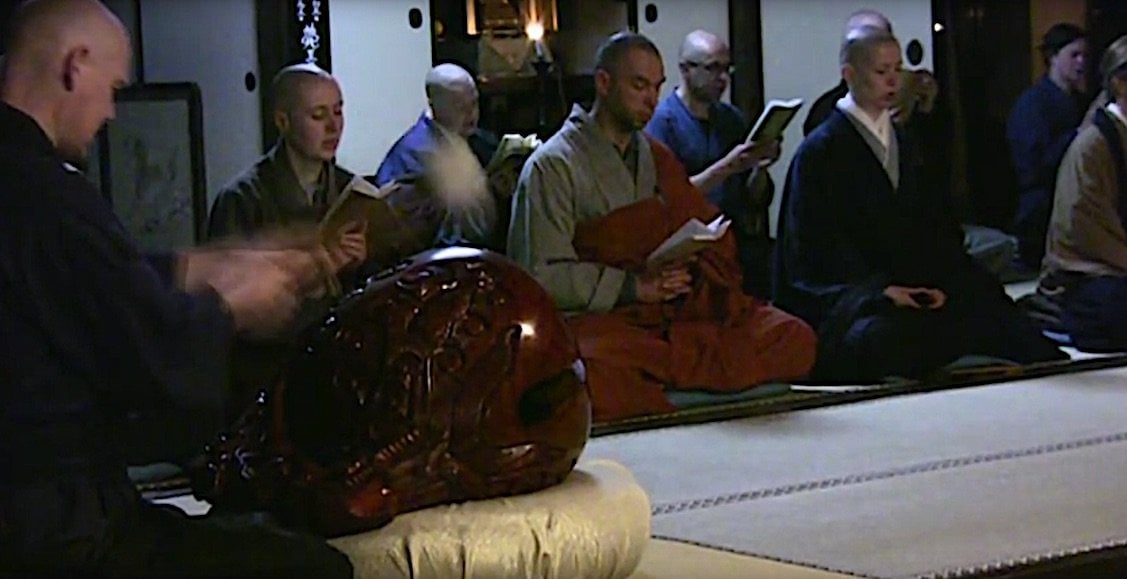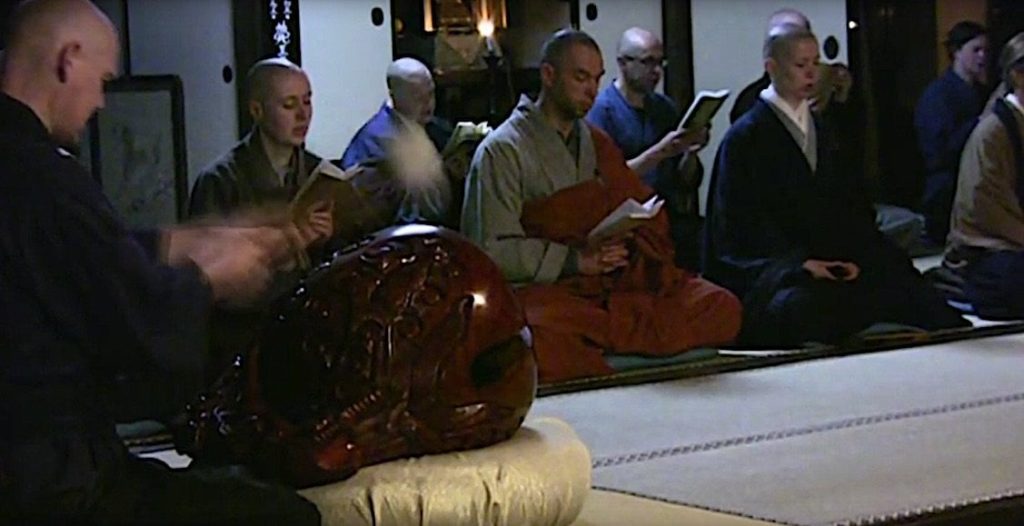
Mokugyo are instantly recognizable by their entirely unique and pleasant penetrating sound that almost seems to hypnotize with its intensity. The use of the fish drum is nearly universally used in ritual and private meditation amongst most forms of Zen or Chan, Mahayana Buddhism and Pure Land Buddhism.
In some ways, practicing drumming — by combining a breathing exercise, or a sutra chant, or mantra or Nembutsu, with repetitious, punctuated wooden drum raps — amplifies our mindfulness practice. The monotonous, hypnotic sound of the drum actually seems to anchor the mind in the present moment faster, with more clarity and riveting focus, than simply watching breath (for some people).
Wakeful Drum — wake up!
Also called the “Wakeful Drum” — because it awakens the mind to its real nature — the drum creates a sense of alertness that keeps meditators from straying into sleep. The fish is symbolic of the wakeful mind — fish never close their eyes. In Chan or Zen, sleeping on the mat could earn you a good wakeup tap. At home, where you have no one to keep you alert on the mat, the drum can help keep you alert but relaxed, in a mindful state, but not with a dull mind.
By whatever name—mokugyo in Japan, muyu in China, mock gnu in Vietnam, moktak in Korea, shingnya in Tibet—the piercing pang, pang, pang of the fish drum can be heard at virtually all rituals. Any chanting of sutras or mantras is likely to accompanied by the trance-inducing wooden fish drum. Taoists and Shinto practitioners have also adopted this powerful little drum.
Drumming while Reciting Sutras
Video of typical practice with drum — recitation of Heart Sutra:
To chant along with Vice-abbot Jason Quinn:
https://www.emptygatezen.com/
The Maha
Prajna Paramita
Hrdaya Sutra
Avalokitesvara Bodhisattva
when practicing deeply the Prajna Paramita
perceives that all five skandhas are empty
and is saved from all suffering and distress.
Shariputra,
form does not differ from emptiness,
emptiness does not differ from form.
That which is form is emptiness,
that which is emptiness form.
The same is true of feelings,
perceptions, impulses, consciousness.
Shariputra,
all dharmas are marked with emptiness;
they do not appear or disappear,
are not tainted or pure,
do not increase or decrease.
Therefore, in emptiness no form, no feelings,
perceptions, impulses, consciousness.
No eyes, no ears, no nose, no tongue, no body, no mind;
no color, no sound, no smell, no taste, no touch,
no object of mind;
no realm of eyes
and so forth until no realm of mind consciousness.
No ignorance and also no extinction of it,
and so forth until no old age and death
and also no extinction of them.
No suffering, no origination,
no stopping, no path, no cognition,
also no attainment with nothing to attain.
The Bodhisattva depends on Prajna Paramita
and the mind is no hindrance;
without any hindrance no fears exist.
Far apart from every perverted view one dwells in Nirvana.
In the three worlds
all Buddhas depend on Prajna Paramita
and attain Anuttara Samyak Sambodhi.
Therefore know that Prajna Paramita
is the great transcendent mantra,
is the great bright mantra,
is the utmost mantra,
is the supreme mantra
which is able to relieve all suffering
and is true, not false.
So proclaim the Prajna Paramita mantra,
proclaim the mantra which says:
gate gate paragate parasamgate bodhi svaha
gate gate paragate parasamgate bodhi svaha
gate gate paragate parasamgate bodhi svaha.
Fish Legend Origin
The fish stands for two things, primarily. The symbolism of the fish is wakefulness — the always open eyes. Fish are also symbolic of wealth and abundance — not necessarily money, but equally the idea of abundant realizations in meditative practice.
In the legend of the fish origin, a monk, on a seventeen-year quest to bring the precious sutras from India to China, found his journey was blocked by a wide, flooding river. A big fish appeared suddenly and offered to carry the monk across the river. He had earned negative karma as a human and was born as a fish. By carrying the monk, he would extinguish the negative karma with a meritorious act. The fish later became a Bodhisattva. However, on the return journey, because the monk had forgotten to make requests of the Buddha, the fish dumped him in the water, sutras and all. The sutras were ruined.
The monk, full of anger, built a wooden fish. When he felt the anger rise up, he would beat the fishes head. To his shock, when he beat the head, the fish opened his mouth and vomited a character. After years of beating the head, from the fish’s mouth, he retrieved what had been lost in the river.
The metaphor is an insightful one. Beating the fish drum in meditation can lead to profound insights.
When is the Fish Drum Used?
The drum is most often used in temples in China, Japan, Korea, Vietnam, Nepal, the United States (mostly in Zen temples) at these times:
- when reciting sutra
- when reciting mantra
- when reciting Nembutsu — Amitabha’s name “Namu Amida Butsu”
- during breathing or mindfulness practice where the alert mind is key
- during rituals, including rites for death or rebirth
- during processions
- in group practice, to keep people alert and in time during chanting
- during rituals or prayers for rain or auspiciousness.
Why use a drum?
We use a drum in meditation to keep us wakeful, mindful, alert. At the same time, the stimulating sound, entirely unique in percussion, has a trance-like effect, allowing something of an altered state of meditation. The sound’s uniqueness also instantly evokes sacredness. The sound travels, apparently on forever, penetrating all of the illusion we call our world, and carrying our mantras and sutras along.
Fish drum doesn’t always look like a fish
The fish drum is hand-carved out of a single block of wood, then hollowed out, smoothed, carved with symbols, then lacquered. Small mokugyo sit on a cushion to make sure the sound is pleasant. Larger temple muku normally rest on a temple stand. When struck by a wooden mallet, with or without felt or rubber striking tips, the sound is entirely unique.
The fish drum doesn’t always resemble a fish. Large fish drums, suspended in Chinese temples, are elaborately carved into fish and painted with gold and red. These giant fish are struck each morning and evening to help us remember all the fish in the sea, and to remind us to be wakeful.
Full Fish Symbolism
Because the fish never sleeps, it becomes a symbol of awakened meditation and even enlightenment. Since most fish adapt to have large eyes, to see in the murky waters, they also represent penetrating sight, overcoming illusion and attachment.
Fish is one of the eight auspicious symbols in Buddhism
The fish is one of the eight auspicious symbols in Buddhism, accepted by all streams of Buddhism. This auspicious symbol is normally two golden fish, symbolic of the Ganges and Yamuna rivers, and represents good fortune in general. Striking the drum reminds us, with each piercing strike, to remember the lessons of the eight auspicious signs.
Hannya Shingyo by Shodo Harada Roshi:
The other symbols are:
- the Lotus, one of the most recognized symbols, standing for the beauty and clarity of enlightenment and the true nature of all beings because the beautiful flower reaches out of the muck
- the Parasol, symbol of royal dignity and protection
- Conch Shell horn representing the sound of the Dharma penetrating the universe to release all beings
- the Banner of Victory: symbolizing Buddha’s victory over Mara, who represents passion, fear of death, pride and lust
- the Vase, filled with sacred items, the never emptying vase is always full and represents long life
- the Dharma Wheel: the eight spoked wheel representing the eightfold path taught by Buddha
- the Eternal Knot: a never-ending symbol that signifies that all phenomena are linked.
Well-being, happiness and prosperity
The fish is a universal symbol of well-being, happiness, prosperity in freedom in all of Asia. This symbolism is partially because fish are always active and a source of a good life, but also because in India—the well-spring of enlightenment—the Ganges river (and its fish life) are sacred.
Good fortune fish are a major part of Feng Shui in China and aquariums are often prominent in homes to bring happiness and prosperity.

